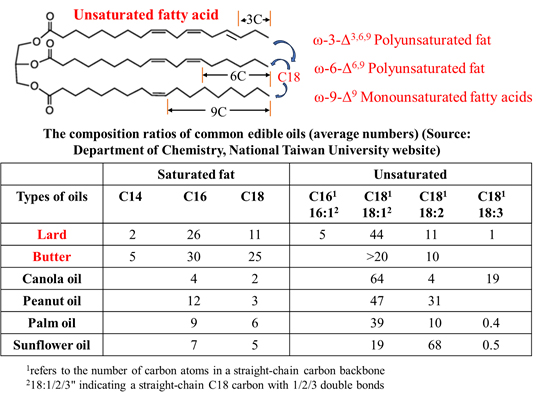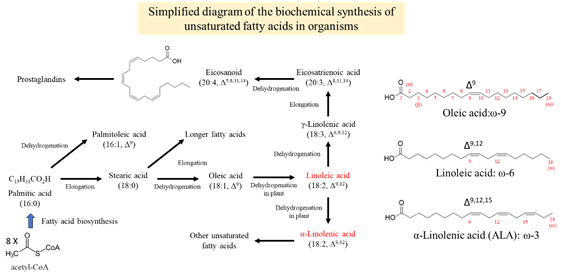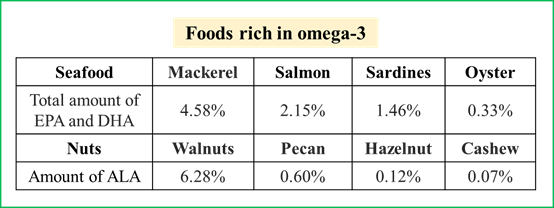The combination of Omega 3 and Omega 6
Dietary guidelines should evolve based on the facts and development of nutritional science. However, abundance of nutrition information nowadays is based on hearsay and lacks sufficient scientific basis. In today's world, promoting a commitment to truth-seeking is crucial, especially when it comes to nutrition. A hundred years ago, dietary guidelines aimed to ensure that people consumed a diverse range of nutrients in their daily diet to prevent illnesses caused by nutrient deficiencies, such as scurvy from a lack of vitamin C. Nowadays, these guidelines have shifted towards moderating the consumption of certain foods to combat obesity, type 2 diabetes, and cardiovascular disease (CVD). Over the past fifty years, until 2002, U.S. dietary guidelines recommended keeping fat intake below 30% to avoid obesity and CVD. However, recent studies suggest this link is weaker than thought. Current guidelines allow for 20-25% of daily calories from fats, emphasizing the importance of choosing healthier monounsaturated or polyunsaturated fats from plant oils to lower CVD risk and support weight management.1 The American Heart Association notes that substituting saturated fats with unsaturated plant oils can cut CVD risk by up to 30%, similar to statins' effects. Studies also show that omega-6 and omega-3 fats, particularly from marine sources, are beneficial for cardiometabolic health.2

Figure 1: Food sources of omega-3 and omega-6.
Let's further discuss how to pair the two beneficial unsaturated fatty acids, Omega 3 and Omega 6, in our diets. First, the table below shows that animal fats like lard and butter are high in saturated fats, exceeding 40%. In contrast, vegetable oils typically contain less than 15% saturated fats, with over 80% being the healthier unsaturated types.
What are Omega 3 and Omega 6?

Figure 2: The composition ratios of common edible oils.
The table above illustrates the structure of triglycerides, which are the building blocks of fats and oils. Within these structures, triglycerides consist of one to three C18 long-chain molecules, each containing between one to three carbon-carbon double bonds. These double bonds are characteristic features of unsaturated fatty acid groups. Based on their structure, they can be further divided into polyunsaturated (with two or three double bonds) and monounsaturated fatty acids. According to the standard chemical nomenclature, chemists have introduced Greek letters, with the first letter being alpha (α) and the last letter being omega (ω). The carboxylic acid C1 position of the fatty acid is designated as the α-carbon, and the last position is the ω-carbon. Unsaturated fatty acids are classified based on the position of the carbon-carbon double bond relative to the omega (ω) end of the molecule. Omega-3 fatty acids have a double bond at the third carbon, Omega-6 at the sixth, and Omega-9 at the ninth. The location and count of these double bonds can also be denoted using the delta (Δ) symbol, such as Δ3,6 for double bonds at the third and sixth positions from the alpha (α) end. The human body cannot synthesize essential fatty acids like Omega-3 and Omega-6 and must be ingested through diet.
The necessity of consuming fats
First, it is important to clarify why we need to obtain 20-25% of our daily caloric intake from fats. It turns out that fats play multiple roles in the body, exerting the following main functions:3
- They store a large amount of energy, which can be converted and released when the body needs it, and subcutaneous fat helps maintain body temperature.
- Most fats are stored in adipose tissue, which has the responsibility of protecting internal organs.
- They act as a medium for the transport and absorption of fat-soluble vitamins A, D, E, and K.
- Fats are the primary raw materials for the production of cholesterol, vitamin D, bile acids, and certain hormones.
- Fats maintain the normal functioning of the nervous system and skin.
The functions mentioned in points four and five might be overlooked by us, yet they are extremely important.
The synthesis of fatty acids
The figure below outlines how organisms biosynthesize unsaturated fatty acids and explains why we should intentionally include Omega 3 and Omega 6 in our diet. Organisms can produce straight-chain saturated fatty acids such as C16 palmitic acid using acetyl-CoA, a form of activated acetic acid, with enzyme catalysis. Enzymes then catalyze dehydrogenation reactions to convert palmitic acid into unsaturated palmitoleic acid. In a separate biosynthetic process, acetyl-CoA molecules extend the C16 palmitic acid by two carbon units, leading to the creation of C18 stearic acid, a saturated fatty acid. Fatty acids are built by adding two-carbon units, resulting in even-numbered chains. The C18 Stearic acid then undergoes dehydrogenation to yield oleic acid, which belongs to the Omega 9 class of unsaturated fatty acids. Animals must obtain linoleic acid, an essential omega-6 fatty acid, through their diet because only plants can convert oleic acid into linoleic acid (18:2, Δ9,12) via further dehydrogenation. Similarly, dietary intake is required for omega-3 α-Linolenic acid (ALA, 18:3, Δ9,12,15), another essential fatty acid. Both linoleic acid and ALA are precursors to vital compounds like arachidonic acid in humans, which is necessary for creating hormones such as prostaglandins.

Figure 3: Simplified diagram of the biochemical synthesis of unsaturated fatty acids in organisms.
We know that sunflower oil and peanut oil contain 68% and 31% omega-6 unsaturated fatty acids, respectively, but have lower levels of omega-3 unsaturated fatty acids. Canola oil, also referred to as rapeseed oil, has a composition that includes up to 19% polyunsaturated omega-3 fatty acids. However, it also has erucic acid (22:1, Δ13) in its content, which is considered harmful to health. In fact, omega-3 unsaturated fatty acids specifically include ALA, EPA, and DHA, three types of unsaturated fats that need to be obtained from dietary sources. Apart from cooking oils, many nuts and seafood are excellent food choices. Walnuts, favored in China for enhancing brain function, contain an exceptionally high level of the omega-3 fatty acid ALA at 6.28%. This amount in walnuts is a hundred times higher than that of tasty cashews. Mackerel is rich in omega-3 fatty acids, with a combined EPA and DHA content of 4.58%, placing them at the forefront of seafood options. The cost of mackerel is also appealing, being over 50% lower than that of salmon, which is the second-highest in omega-3 content. Additionally, oysters, commonly found at buffets, have a total EPA and DHA content of 0.33%.

Table 1: Examples of foods rich in omega-3 and their amounts.
Our bodies can extend the length of ALA through enzymes to synthesize EPA and DHA. Consuming appropriate amounts of omega-3 and omega-6 unsaturated fatty acids is confirmed to reduce the risk of cardiovascular diseases. Moreover, recent studies have found that EPA and DHA have protective functions against inflammation and cognitive decline (see note 5). DHA plays a crucial role as a primary constituent of phospholipids in the membranes of the brain and retinal cells. Insufficient levels of DHA may impact the growth and functionality of these tissues. Hence, it is strongly advised that children increase their seafood intake to promote healthy brain development and function. Linoleic acid (LA) and ALA have complementary effects on inflammation but they compete for elongation enzymes in the human body. When there is an overconsumption of linoleic acid, it can hinder the creation of EPA and DHA. This can result in a disruption of the body's natural balance in synthesizing 20- and 22-carbon polyunsaturated fatty acids derived from omega-6 and omega-3 series, respectively.

Figure 4: Biosynthesis of EPA and DHA from ALA by enzyme.
A current dietary topic of interest is finding the right food combinations to obtain the optimal balance between omega-6 and omega-3 polyunsaturated fatty acids. Western diets often feature an excessively high ratio of omega-6 to omega-3, sometimes reaching an extreme 20:1. Such eating habits contribute significantly to obesity, a known risk factor for chronic diseases including cardiovascular disease and diabetes. Is there a so-called golden ratio for the proportion of these two in food? Online information is varied, with different numbers appearing. I believe that the 5:1 ratio proposed by the "American Society for Nutrition" is the most credible. Nutrition experts advise individuals with an unbalanced diet to rectify this disproportion by including foods high in EPA and DHA, or by taking fish oil supplements. The market offers a variety of fish oil products touting their EPA-DHA levels for consumers to select. Yet, any child who has tried fish oil might argue that these capsules are hardly a palatable or easy-to-consume option, often being quite unpleasant to the taste. As an alternative, I suggest buying seafood that is naturally abundant in EPA-DHA. With proper culinary techniques, it can be transformed into tasty meals, providing a wholesome and feasible approach to diet improvement.
Reflections of life
"The old Chinese saying, 'Food is the first necessity of the people,' reflects the importance of diet in our lives." Eating lets us enjoy all the different foods that nature gives us. However, it is not enough to just be picky about what we eat. We should also make sure to exercise regularly. Do not expect that weight loss drugs can solve all your weight problems. Let me share a thought-provoking piece of news from today's Ming Pao website: In the past, many students loved to call Lam Chi-yuen “Panda Sir” because of his round figure and face, as well as a pair of dark circles under his eyes. However, through the commitment of walking over ten thousand steps daily for about a year, he managed to lose over 50 pounds. In the subsequent five years, he continued to work hard to maintain his weight without rebounding. Now, he weighs a full 52 pounds less than he did in the past. Walking ten thousand steps a day is neither too difficult nor too easy, but aiming to reduce one's weight by a quarter is certainly a commendable goal. Avoiding obesity is a choice that benefits one's health for a lifetime. I recommend that seniors actively establish a routine of regular exercise."
References
- Torres-Gonsalez, M. The Relationship between Whole-Milk Dairy Foods and Metabolic Health Highlights an Opportunity for Dietary Fat Recommendations to Evolve with the State of the Science. Nutrients 2023, 15 (16), 3570
- Wu, J.H.Y.; Micha, R.; Mozaffarian, D. Dietary fats and cardiometabolic disease: Mechanisms and effects on risk factors and outcomes. Nat. Rev. Cardiol. 2019, 16, 581–601.
- Centre for Health Protection. Know More About Fat. 2024. https://www.chp.gov.hk/tc/static/100023.html
- Nuts for Life. Omega-3 fatty acids in nuts. 2022. https://www.nutsforlife.com.au/resource/omega-3-fatty-acids-in-nuts/
- Swanson, D.; Block, R.; Mousa, S. A. Omega-3 Fatty Acids EPA and DHA: Health Benefits Throughout Life. Adv Nutr. 2012, 3 (1), 1-7.
- https://news.mingpao.com/pns/%E8%A6%81%E8%81%9E/article/20240214/s00001/1707847583450/%E5%BE%9E%E5%89%8D%E6%9A%B1%E7%A8%B1%E3%80%8C%E7%86%8A%E8%B2%93%E5%85%88%E7%94%9F%E3%80%8D-%E6%97%A5%E8%A1%8C%E8%90%AC%E6%AD%A5%E6%B8%9B%E9%80%BE50%E7%A3%85
By Prof. Chan W. H.
Translate by Dr. Yim K. H.